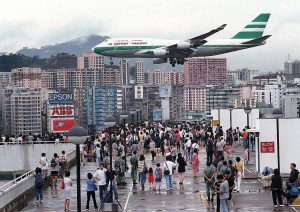Discovery Channel Magazine: Extreme Airports and the Pilots who Tame Them
Euromoney: Goldman Must Open its Books on Libya
1 January, 2015Forbes.com: Why Investors in China May Face a Bleak 2015
5 January, 2015Discovery Channel Magazine, January 2015

(FREDERIC J. BROWN/AFP/Getty Images)
Phillip Pollard was on his maiden trip as a First Officer at Qantas, and it was a great one: Sydney to Hong Kong and Bangkok, then back to Hong Kong, Singapore and Sydney. After five years in the back seat for take-offs and landings as a second officer, this was a big moment. His captain handled the landings on the way out, and then, as an expression of confidence, invited Phillip to fly the sector back from Bangkok to Hong Kong, including the landing.
“This was quite a gesture for the captain, given that I had just finished my First Officer training,” Phillip says now. That’s putting it mildly, because back then, Hong Kong’s airport was Kai Tak.
Kai Tak! To this day, 16 years after its closure, people still get misty-eyed – or have panic attacks – talking about this most extraordinary of airports. These days you can only make out the shape of the old runway, as a new cruise terminal sits on top of it, and landings instead take place over on the edge of Lantau Island in efficient and airy Chek Lap Kok. But for 73 years, Hong Kong’s air traffic came into Kai Tak, and the airport was a part of the city’s soul, a perfect representation of the borderline chaos of the place’s commercial fervour.
From the passenger’s perspective, the landing was as memorable as any could be. You would start to descend over green Lantau Island before settling in to an approach with the hills behind Kowloon to your left, and Hong Kong Island visible over to the right. Down and down you would go, until to left and right you would be among Kowloon’s buildings, buildings that were considerably higher than the plane. You could pretty much see what the inhabitants were watching on TV, make out individual items of laundry hanging on poles from the windows. Then you would start to bank right, and further and further and further right, as alarm rose in your gut. This can’t be right! you would think, trying to compensate for the turn with your body, as if shifting your bum cheeks a bit to the left would bring a jumbo jet back on its axis, until finally, finally, it would begin to level just feet from the ground and hammer down onto the runway, reverse thrust firing instantly as the pilot sought to stop the plane pitching into the harbour at the end. And then as you taxied parallel to the runway, another plane would land, and another, and another, until you were finally bussed from the apron to the dismal and decaying terminal, glad to be alive.
To read more, contact me or Discovery Channel Magazine
